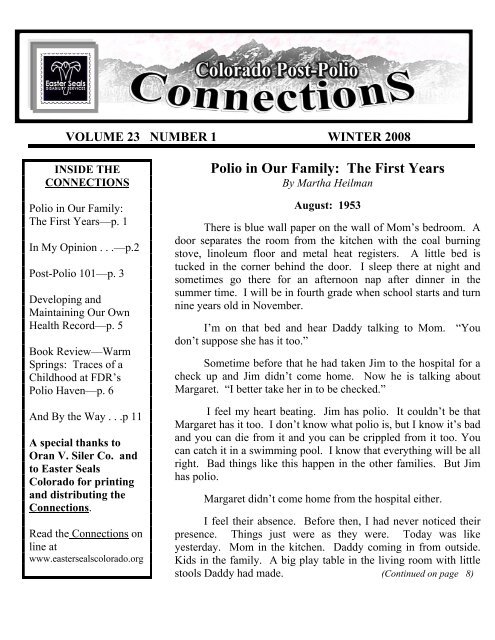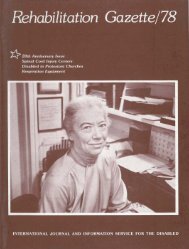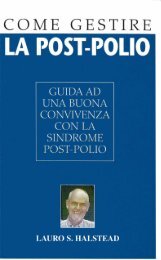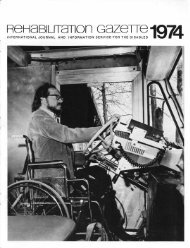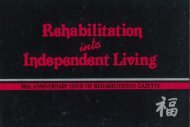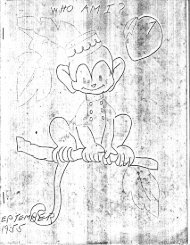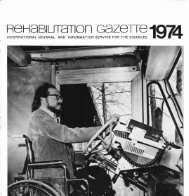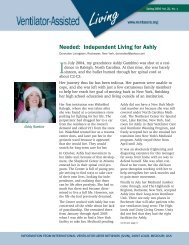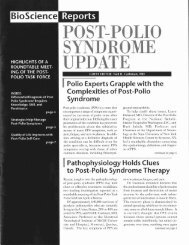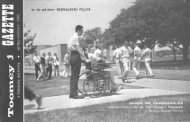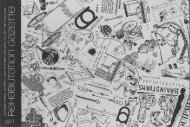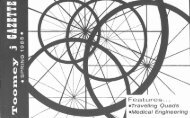Winter 2008 (Vol. 23, No. 1) - Polio Place
Winter 2008 (Vol. 23, No. 1) - Polio Place
Winter 2008 (Vol. 23, No. 1) - Polio Place
- No tags were found...
You also want an ePaper? Increase the reach of your titles
YUMPU automatically turns print PDFs into web optimized ePapers that Google loves.
VOLUME <strong>23</strong> NUMBER 1 WINTER <strong>2008</strong>INSIDE THECONNECTIONS<strong>Polio</strong> in Our Family:The First Years—p. 1In My Opinion . . .—p.2Post-<strong>Polio</strong> 101—p. 3Developing andMaintaining Our OwnHealth Record—p. 5Book Review—WarmSprings: Traces of aChildhood at FDR’s<strong>Polio</strong> Haven—p. 6And By the Way . . .p 11A special thanks toOran V. Siler Co. andto Easter SealsColorado for printingand distributing theConnections.Read the Connections online atwww.eastersealscolorado.org<strong>Polio</strong> in Our Family: The First YearsBy Martha HeilmanAugust: 1953There is blue wall paper on the wall of Mom’s bedroom. Adoor separates the room from the kitchen with the coal burningstove, linoleum floor and metal heat registers. A little bed istucked in the corner behind the door. I sleep there at night andsometimes go there for an afternoon nap after dinner in thesummer time. I will be in fourth grade when school starts and turnnine years old in <strong>No</strong>vember.I’m on that bed and hear Daddy talking to Mom. “Youdon’t suppose she has it too.”Sometime before that he had taken Jim to the hospital for acheck up and Jim didn’t come home. <strong>No</strong>w he is talking aboutMargaret. “I better take her in to be checked.”I feel my heart beating. Jim has polio. It couldn’t be thatMargaret has it too. I don’t know what polio is, but I know it’s badand you can die from it and you can be crippled from it too. Youcan catch it in a swimming pool. I know that everything will be allright. Bad things like this happen in the other families. But Jimhas polio.Margaret didn’t come home from the hospital either.I feel their absence. Before then, I had never noticed theirpresence. Things just were as they were. Today was likeyesterday. Mom in the kitchen. Daddy coming in from outside.Kids in the family. A big play table in the living room with littlestools Daddy had made. (Continued on page 8)
Page 2In My Opinion. . .Last October, I took the initiative and talked with my sister and two of my brothers, oneof whom also had polio at the same time I did, about our polio experience. It only took me 54years to do that and the results were wonderful. We shared our memories of that time, how wesaw things, what we understood, and how we felt. I had talked with my youngest brother manyyears ago. He was a baby at the time and I naively asked him about my polio. His responsewas that he never knew me to be any different than I am. In hindsight, what else would he say?However, my sister and my brothers who are closer to me in age had never talked aboutour experiences. The result of our sharing was in itself interesting, a sharing of forgottenmemories and details and perspectives, leaving us with some holes in the story that probablywill never be filled. As we tried to piece together our shared information, I realized that mygreatest adult resources about that time, my parents, who are no longer living, are no longeravailable to talk about what happened.Out of our time together, I received perhaps my greatest gift, a written memoir by mysister, who was eight years old when I had polio. I am now at an age when family history isimportant to me and so her story is a treasure. Her memoir paints a bigger picture of the impactthat my polio had on my family and provides pieces of the picture that have been missing. Ithas opened up for me a new, broader perspective on my experience. I hope that by sharing herstory, some of you might want to copy my experience and talk to members of your family aboutyour experiences.This leads into the focus of the rest of the newsletter, the value of keeping our ownmedical records, with an article written by Jim Oxley. Some sort of system for doing so makesour navigation through the health care world much easier for us. It is also part of our personalhistory. Included in this issue is also a two page summary of polio entitled “Post-<strong>Polio</strong> 101”from <strong>Polio</strong> Epic, Inc. in Tucson, Arizona which can be clipped from the newsletter and keptwith your medical records. It is a comprehensive and efficient means of communicating withyour health care professionals on the issues facing polio survivors.Another related article is the book review on Warm Springs by Susan Richards Shreve, amemoir of her polio experience. In the review, Ileta Smith shares her personal response to theauthor’s experience, which has as much impact as her summary of part of the book.On another note for those of you who want to keep up with the latest information onpolio and post-polio syndrome and who like to travel, Post-<strong>Polio</strong> Health International will behosting their conference at Warm Springs, Georgia in April or May of 2009. The locationprovides attendees an opportunity to see where Franklin D. Roosevelt spent his time and wheremany polio survivors were treated over the years. It will also be an opportunity to meet othersurvivors and learn something about our shared experiences. More information to follow as itbecomes available.Margaret C. Hinman, editor
Page 5Developing and MaintainingOur Own Health RecordBy Jim OxleyWhy on earth do we need to havemedical records? Doctors, therapists,hospitals and clinics keep records of us.There are paper and computer trails outthere that we can access. But, if we don’tkeep track of our own medical information,such as list of pills, last physical, bloodpressure, cholesterol, inoculations, phonenumbers and weight how can we recall thesedetails when we need them? After all, ouraging memories aren’t always reliableeither. A Special Report from In Motion, byDupes and Mathis, states that completemedical information is needed should wemove or change doctors. They add that therecords ensure accuracy and save time.A self-kept record of importantmedical information (a medical diary, if youwill) becomes a necessity and is useful to usfor the above reasons and more. It isparticularly important for some of us to haveour records available for use by ourcaregivers, spouses and family members.Another good reason to keep an account ofour health is to have questions or commentsready for our next doctor’s visit. (Leavespace for noting the major points that yourdoctor makes during every visit.) As most ofus have experienced, referrals made by ourdoctor, therapist or other care providersalways preface the visit with questions aboutour medications, last physical, andsymptoms of note. If we have our recordswith us, we won’t be embarrassed by sayingwe don’t know or remember.With doctors asking more and morequestions about our family history, weshould record that information where it canbe accessed easily. And why not put that inyour medical journal? Then when thequestion is raised “Is there any cancer inyour family?” we can refer to our journaland accurately relate that information to ourdoctor. Certainly our polio history should bein a place where family or caregiver can findit. We should list our concerns and cautionsabout anesthesia, fatigue, food allergies,postoperative recovery time and more. Alsoone can list insurance carriers andappropriate medical card numbers. We maywish to list the location of our living will,medical power of attorney and organ donorwishes.So, is there a right or wrong way tokeep records? With access to computersnow, our records can be kept on a computerdisc, on a portable USB drive or “memorystick” for immediate access, or filed in someother form. A recent book by Laura Casey,How to Get the Health Care You Want, hasa chapter on “Creating and MaintainingYour Own Health Record.” She goes intodetail on all kinds of records one can keepand the software available to do it. Herwebsiteis:www.howtogetthehealthcareyouwant.com.The American Hospital InformationManagement Association (AHIMA) hasmade available to anyone a set of forms forrecording all appropriate personal healthinformation. Logging on tohttp://myphr.com/your_record/record_contents.asp can access it. These forms can befilled out on the computer or by longhandand made part of our health journal,notebook, a computer disc or other form forfiling. Hospitals and doctors are using thismeans for their files. Of course, we have toupdate these as changes (Continued on page 6)
Page 6Developing and MaintainingOur Own Health Records(Continued from page 5)occur in our personal information. AHIMAhas created forms for both adults andchildren. Share this website with yourchildren and grandchildren to “kick start”their own record keeping!My comment with respect to both ofthese sources, which are very useful, is thatif keeping our health information becomestoo detailed or complicated, we are liable togive up and not keep any records at all.I have been keeping my medicalrecords for a number of years after the topicwas discussed at a support-group meeting. Ichose to use a bound journal or ledger forwriting things down after any medicalintervention in my life. This technique hashelped me to acquire the habit of jottingnotes down, much like keeping up with adiary. It is easily carried to yourappointments and especially useful whenone sees a different or new provider.In summary, the most important stepis to begin the process and use whateverform of recording that is easy. Keeping itsimple prompts one to develop the habit of“just doing it.” Dates of treatments andappointments, doctor’s visits, hospital staysand so forth, followed by a few notes orcomputer printouts fastened in the notebookcan be a beginning point. Remember thatyour medical records are available to you bylaw and that you can have them duplicatedfor your own use, usually without cost.Beyond that, more detail can be added andnotes of historical importance incorporatedin your record as part of your health journal.You may want to ask a caregiver or friendnot only to accompany you to yourappointments but also to help you record themost salient information from your visit.References:Casey, Laura L. 2007 “How To Get theHealth Care You Want,” 1 Life Press. P.O. Box26644, Austin. TX 78755American Health Information ManagementAssociation, <strong>23</strong>3 <strong>No</strong>rth Michigan Ave., Chicago, IL60601-5800. 2007.Dupes, Bill and Lee Mathis, “TheImportance of Keeping Copies of MedicalRecords,” In Motion, <strong>Vol</strong>. 17 Issue 4, July/August2007, pp.18-20.11/19/07Warm Springs: Traces of aChildhood at FDR’s <strong>Polio</strong>Haven By Susan Richards ShreveReviewed by Ileta SmithSusan contracted polio at the age ofone, and entered the sanitarium at WarmSprings, Georgia when she was eleven.Prior to her arrival at Warm Springs, hermother had devised her own regimen ofexercises for Susan. All through herchildhood, Susan and her mother spent theirdays “on the floor, on the bed, standingagainst the wall, doing a long series ofexercises.” Her mother was alwaysdeveloping new games, stories, and funthings to do to make the exercises seemmore like games than work. Susandeveloped a storytelling attitude about life.Always changing situations to have a happyever after ending. By the time she wasthree, she could walk with braces, holdingher mother’s hand or swinging back andforth in a kind of jump step, moving forwardby throwing her hips ahead of her. (See page7)
Page 7Book Review: Warm Springs(Continued from page 6)It was around this time that Susan’sdoctor had arranged for her to be the subjectof a lecture by Sister Kenny at Washington’sDoctors Hospital. Sister Kenny was aphysical therapist with no formal medicaltraining. She had decided instinctively thatthe paralysis and stiffness associated with<strong>Polio</strong> were due to muscle spasms anddevised a treatment of hot packs which sheused to help the muscles relax.Sister Kenny was already on stage,and looking at the audience as Susan waswheeled out on a stretcher wearing an oversizedgown and covered by a sheet. Susanintroduced herself. Sister Kenny’s responsewas to look down and with a “grandgesture” tear the sheet from Susan. Shebegan reciting factual information; thechild’s name, age, type of polio, when it wascontracted, physical deformities, etc. Shecontinued by telling the audience that “thepatient has been treated by methods devisedby her mother. These methods have neverincluded the application of hot cloths ormuscle stretching or reeducation of thedamaged muscles.” And so she swoopedSusan off the stretcher, stood her on thefloor, and told her to walk. After Susan tookfive or six unsteady steps, Sister Kennylifted her back to the stretcher, raised herhands in a gesture of defeat, and replied,“By the time she is twelve years old, thischild will not be able to walk any longer.”With that, Susan’s doctor rushed up to thestage, gathered Susan in her arms, left thestage, dressed her, and gave her to hermother. Susan felt she had let her motherdown. Her mother apologized to her forwhat Sister Kenny had said.This experience was one of manyharsh and confusing interactions Susanexperienced during her childhood. Her storyhas an underlying sense of sadness, of notbeing worthy, of being a trouble maker. Atage eighteen, Susan had written anunpublished novel about a girl with mildparalysis who went to Warm Springs. Afterrereading the manuscript some forty yearslater, she was surprised at how different herpresent memory of her time at WarmSprings was from that of her youth. Peoplethought she was blessed with a sunnydisposition. Susan didn’t realize until shewas in her twenties that the image of her as ahappy-go-lucky, fearless girl was in fact aninvention for both she and her mother.Susan’s Warm Spring journey beganthe night before she was to be admitted. Hermother, father, and brother all slept in thesame double bed in a small hotel. Susanslept on the floor, afraid to test her ownemotional strength by giving in to thecomfort of her family. The next morning atWarm Springs, as she waited to be admitted,she noticed Joey Buckley and immediatelyincluded him in her vision for her life. Joeywas thirteen, and dreamed of playingfootball for Alabama. They spent a lot oftime together during their stay at WarmSprings sharing words of encouragement,and companionship. She loved him andconsidered him hers. They both had severalstabilization surgeries and painful muscletransplants while at Warm Springs.Susan’s ward was arranged with bedson each side. The girls who were to havesurgery within a day or two were closest tothe door. As their surgery was completed,they would be rotated (See page 8)
Page 8Book Review: Warm Springs(From page 7)farther into the room. She recounts how shespent her days at Warm Springs;experimenting with different religions,helping in the baby ward, helping with bedpans and food trays, befriending a youngmentally disabled child of a staff member,and of course, spending time with Joey.One Thanksgiving, after beingdisappointed that she would not be goinghome for the holiday, Susan felt subdued, asif some of her former self had vanished andshe was left with the shell of the girl she hadbeen. She was getting more positivecomments from the staff, since she no longerhad the drive to exert herself with theexuberance she had displayed previously.Joey was getting ready for reconstructivesurgery and was supposed to put on weight,so on the days Susan passed out the foodtrays she would bring him Clark bars andextra ice cream.As Susan and Joey were going to themovies, they had to move their wheelchairsvery slowly down a hill. “There was a long,steep dip of cement walk from the levelground of the first floor of the hospital to themovie theater room on the basement level.”Susan suggested that they might race downthe hill when Joey got out of surgery. Abouttwo weeks after his surgery, Joey wasscheduled to go home. They decided to dosomething special to celebrate . . . racing thehill.Susan had always been told that noone left Warm Springs until they were aswell as possible. The next morning, afterthe race, her Warm Springs journey wasending. She was told she was going home.She protested saying she wasn’t that well,that she could hardly walk, and was in muchpain. She was told she was well enough togo home. Her roommates avoided eyecontact, and conversation. Her fatherarrived wearing a suit. He wasn’t angry.“He wasn’t anything at all, simply a fatherwho had come to pick up his daughter,dismissed in disgrace.” He was told that ifSusan continued to work hard, there was noreason she couldn’t be better than when shearrived, but it would take time, years even.Joey had broken both his legs in therace. She never saw or heard from himagain.I found the book to be interesting, butnot always flowing chronologically. It wasa series of memories of her childhood. Thebook was written similarly to how we mightrecount our own memories. You know, howwe remember things, but not necessarily inthe order in which they happened. I felt shewas still trying to come to terms with herown feelings. How her experiences, and herperception of those experiences, hasinfluenced her outlook today. I wouldn't saythis was a "feel good" book, but very real. Icould relate and remembered very similarexperiences in my own childhood. I did notfind it to be uplifting, but it did remind methat I am not alone in the unpleasantmemories of growing up with polio,spending a lot of time away from my family,and at the mercy of those around me.<strong>Polio</strong> in Our Family (From page 1)Doing dishes with Margaret. Cleaning thehouse with Margaret on Saturday to getready for church on Sunday. Walking to themailbox to take the bus to school. Goingbarefoot on hot summer days. (See page 9)
Page 9<strong>Polio</strong> in Our Family (From page 8)Twinkle Time, Bobby Benson and SergeantPreston on the radio. All the family in thegreen Chrysler. Sometimes comic books fora treat after Mass.Time passes. It’s Sunday after Massand we’re in Thompson’s drugstore. It’s thefirst time I remember all of us going in.Usually Mom waits with us in the car whileDaddy goes in to buy something. Us kidswent in that day because Mom and Daddyare looking for something for Margaret andJim to have in the hospital and theywouldn’t leave us alone in the car. Theyagree that they should get something for theother kids too. I look around carefully. Iknow what I choose shouldn’t cost too muchmoney. On the shelf I see a package holdinga little toy oven that bakes small cakes.Everything you need to do it is there. I’vealways wanted one. I show Mom. She saidit would be a waste of money because youcould only use it once. She sees the longingin my eyes and says, “OK.” I know she’sright; I feel guilty and sorry I asked for it,but take it anyway because I haven’t thecourage to choose something else. I know Igot it because Margaret and Jim have polio.We’re home from church in thekitchen. Mom walks in the door, quiet andsad. She turns to Daddy and bursts intotears. He puts his arm around her waist andwalks her to the couch in the living room.She is sobbing. She is my life. I amterrified. He talks to her in a low voice andshe continues to weep. “She just lays there,”Mom sobs. “She doesn’t say anything orlook at you.” Daddy holds her and talks.She cries.I wrap my arms around myself toquiet my fear. I get an idea. I will bake thelittle cakes in my oven and give them to her.It will make her feel better. She will likethem and like me for giving them to her.I carefully read the directions. Theoven is powered by a light bulb. I mix thepowder with water and pour it into two littlepans. It takes a long time for them the bake.Finally they are done. I wait for her to comeout of the living room.A long time goes by. She’s not cryingany more, just sitting there with Daddy.More time. I think she must be ableto eat a cake now. I carefully take one to thedoor with the tiny fork. “I made this foryou.” I say. There is a pause. She looks atme sadly. “Oh Martha, I’m sorry, I justdon’t feel like eating now. You should goahead and eat it.” She doesn’t hug me. Iwalk away.I sit the cake on the counter and wait.She doesn’t come out of the room. Shestays with Daddy. More time passes. Andmore. Finally I take the little cakes and eatthem. They don’t taste very good. She wasright.We’re all going to the hospital to getshots because Margaret and Jim have polio.They are in the hospital but we can’t seethem because they are in isolation. Thatmeans they’re too sick to have visitors andcould get sicker if people visited them andbrought germs in. They show us the doorsto the part of the hospital where they are.Lenny and David and Ray get theirshots. The baby Jerry is too small. I noticeRay stands up afterward (See page 10)
Page 10<strong>Polio</strong> in Our Family (From page 9)and I see his peeper. I think he should bemore modest. Then I get the shot. It feelslike the shots we got during the school yearexcept it’s in our bottoms, not our arms. It’sless scary because you can’t smell thealcohol or hear other kids crying. I don’t cryand can’t remember if the boys did.School starts. Mrs. Salverson is myteacher. She tells the class that some of thestudents got polio during the summer. Shesays my sister and brother got it and so didPaul Schulte. We’ll write letters to them,she says. And we do. Margaret is still inthe hospital. Jim will come home soon.Margaret is very sick. She needs togo the hospital in Helena to get bettertreatment. Daddy puts a piece of plywoodin the back seat of the car and makes a bedfor her there. We don’t see her before sheleaves.Mom says we should write letters toher. I write her often and hope people willnotice how good I am. Once I write her allthe parts of a story I’ve read. It doesn’tsound good to me, not as interesting as thebook, but I’m proud I wrote so much.<strong>No</strong>body notices. I hope she likes it, butsecretly think it will be boring for her.Jim is home from the hospital and thesame as he was before.Margaret gets to come home forChristmas on the train. She walks into thehouse with metal crutches wearing a dressand a heavy brace connected to brownshoes. I didn’t expect that. She talks aboutmaking leather purses at the hospital andgoing swimming. She has a friend whosename is Delores. She isn’t sad. She’s stillsmart and seems really grown up.Spring and <strong>Winter</strong>: 1954Things change when Margaret comeshome for good. It takes a long time to walkwith her because she has to go slow, but shecan climb stairs and stand up good enoughto take a shower. Daddy takes her and me tosee Brigadoon at night at Custer HighSchool. We’d never seen a play before andthis one had songs in it to help tell the story.She and Daddy take a class in tooling leatherand making leather belts. A man we metwhen we went on a family car ride sent her arock collection in the mail because she hadpolio.Margaret’s leg gets really cold andthat changes some things. We used to walkup to the mailbox to catch the bus and walkhome at night even when it was freezingcold. <strong>No</strong>w when it’s cold Mom drives thecar up to get us. Pretty soon she comes inthe car even when the weather is nice. Imiss not being able to run home andsometimes I don’t go in the car. I walkhome by myself.Hanging clothes on the clothesline inthe winter and taking them down is theworst. We used to have to do it together.<strong>No</strong>w I have to do it by myself because shemight slip and her leg gets cold. I hate it.It’s freezing, freezing cold. I also have to bethe one to always go downstairs to get cansof vegetables and it’s my job to keep the firegoing in the hot water heater. If I forget toput coal in and the (Continued on page 11)
Page 11<strong>Polio</strong> in Our Family (From page 10)fire goes out, I have to make a new fire,which I hate. Your hands get dirty with coaldust from putting the kindling in. When Ifirst started doing the down stairs jobs it waskind of scary because sometimes snakes getin. I got used to it though and wasn’t afraidanymore. Anyway, the point is thatMargaret can go up stairs to get to thebedroom, but she never has to godownstairs. I have to do it all. It’s not fair.There’s one more change. They’regiving everybody shots now so no one willget polio anymore. The main thing is thatMargaret really hasn’t changed. She hastrouble walking, that’s all.And By the Way. . .<strong>Polio</strong> survivors want their health careprofessionals to know up front:• All prescription medications,including dosage• All non-prescription medications andsupplements used• Family history• Allergies• Surgeries• Where x-rays are• Physical limitations and needs, i.e.,help getting on the examination table,and/or inability to use one or more oftheir limbs• Presence of arthritis• Oxygen levels• Ventilator information—Liters ofOxygen• Breathing problems• Swallowing problems• <strong>Polio</strong>, post-polio and potentialanesthesia complications• Contact numbers—who to call in anemergency• Living will and medical durablepower of attorney• “Do <strong>No</strong>t Resuscitate” instructionsSome polio survivors share that informationby organizing and using:• A 3-ring binder of all medicalinformation, which is taken to eachmedical appointment• A diabetic diary• A notebook, divided by medicalproblem and treatment done• A medical journal• Information stored on a computer disc• A reduced print size of medicalinformation printed from thecomputer so that it can be kept in awallet or a small plastic case• A Medical Alert Bracelet• The File of Life or Vial of Life, firedepartment or government sponsoredsafety alert programs• A fireproof box to store theinformation at homeMeetings and ConferencesEaster Seals Colorado and Colorado Post-<strong>Polio</strong> Connections will hold aneducational meeting at the LakewoodHoliday Inn, Hampden and Wadsworth onSaturday, May 10, <strong>2008</strong>. Info to be mailed.The 2009 Post-<strong>Polio</strong> Health InternationalConference will be held at Warm Springs,Georgia in April or May 2009. Informationwill be available on the Post-<strong>Polio</strong> HealthInternational web site at www.postpolio.org.
This Is Your Newsletter-----Colorado Post-<strong>Polio</strong> Connections is a newsletter by and for polio survivors, their friends andothers who are interested in being part of our network. The editors and staff invite yourcontributions to the newsletter. If you have comments, articles, or suggestions for topics forfuture issues, please email us at post-poliocolo@comcast.net or write to us:Colorado Post-<strong>Polio</strong> ConnectionsEaster Seals Colorado5755 West Alameda AvenueLakewood, Colorado 80226Please include your name, address, phone number and email address in any correspondence. Tochange mailing information, contact Nancy Hanson at 303-<strong>23</strong>3-1666, ext. <strong>23</strong>7 or email her atwww.nhanson@eastersealscolorado.org.Our next issue will focus on keeping control of our lives—Preventing falls. We needsuggestions from you as to what you do or have done to prevent falling as we age for our “AndBy the Way. . .” column.DisclaimerThe opinions expressed in this newsletter are those of the individual writers and do not necessarily constitute anendorsement or approval by Easter Seals Colorado or the Post-<strong>Polio</strong> Advisory Council. If you have personalmedical problems, consult your own physician..Colorado Post-<strong>Polio</strong> ConnectionsEaster Seals Colorado5755 West Alameda Ave.Lakewood, CO 80226FREE MATTER FOR THEBLIND OR HANDICAPPED


